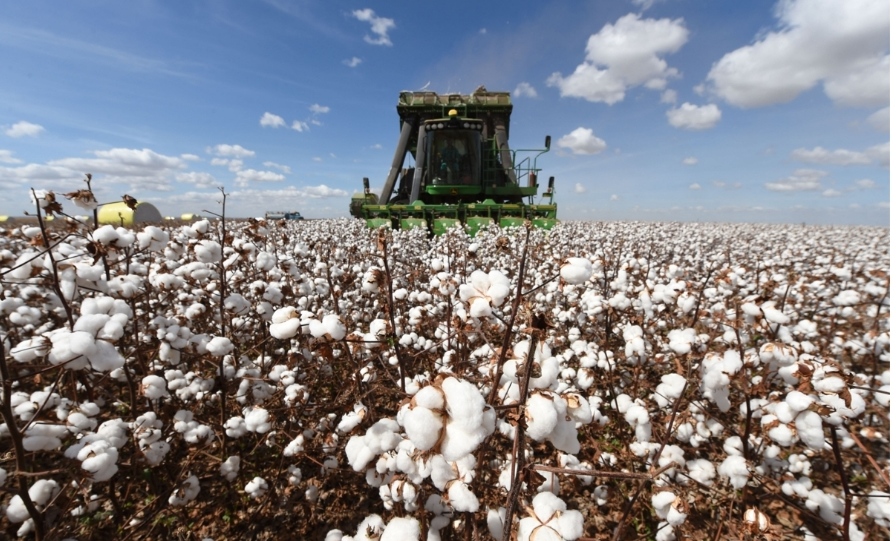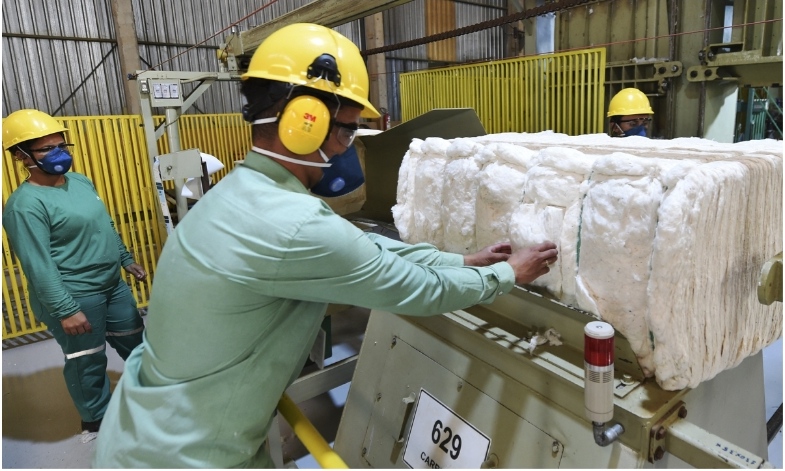Brazilian farmers bet on environmentally friendly cotton
Sustainable farming

A combine harvests cotton in a field at Pamplona farm in Cristalina, Brazil, on July 14, 2022.
The road through Cristalina, Brazil is in the middle of the tropics, but the fields on either side look like they are covered in snow with little white puffs of cotton stretching to the horizon.
The alabaster plants interspersed with the corn and soybean fields outside the central-western town are part of a silent revolution in Brazil: Facing negative attention over the agribusiness industry’s environmental impact, farmers are increasingly turning to cotton and adopting sustainable techniques to produce it.
After increasing exports 15-fold in the last two decades, Brazil is now the world’s second-biggest cotton supplier, after the US – and the biggest producer of sustainable cotton.
No less than 84 percent of the cotton grown in the South American agricultural giant is certified by the Better Cotton Initiative, an international nonprofit group to promote sustainable cotton farming.
“Consumers have changed. People don’t want to buy products any more that don’t respect nature and its cycles,” says entomologist Cristina Schetino of the University of Brasilia, who specializes in cotton farming.
In 2005, the Brazilian Cotton Producers’ Association (Abrapa) launched a sustainability training program for farmers and introduced protocols on efficiently using water and pesticides and phasing out toxic products in favor of biological fertilizers.
A new tracing program launched with Brazilian clothing brands, meanwhile, lets consumers check how cotton goods were produced.
Last season, cotton farmers in Brazil replaced 34 percent of chemical pesticides with biological ones, Abrapa says.
They have also started using drones to apply pesticides more efficiently.
Switching to sustainable techniques is “a reeducation process,” says Abrapa’s executive director, Marcio Portocarreiro.
“At first, farmers tend to think mainly about the impact on their bottom line. But when they get past that phase… they realize that farming sustainably gives them a guaranteed market.”
‘Added value’
Located outside Cristalina, around 130 kilometers south of Brasilia, the capital, Fazenda Pamplona is one of Brazil’s biggest proponents of sustainable cotton.
The 27,000-hectare operation, run by agribusiness giant SLC Agricola, is like a small city in the middle of the countryside, with a banquet hall, a children’s park, sports fields and housing for employees.

Workers take samples from cotton bales at the Pamplona farm in Cristalina, Brazil, on July 14, 2022.
The farm aims to retain workers by creating a home where they will want to stay, says production coordinator Diego Goldschmidt.
He stands in front of two enormous bales of cotton, labeled with QR codes that detail their harvest.
“These are already sold,” Goldschmidt beams.
The farm produced more than 600,000 tons in 2021, 99 percent of it for export.
Sustainable cotton sells for prices up to 10 percent higher than conventional cotton.
“Besides being the right thing to do for society and the environment, it provides added value,” says Goldschmidt.
Aiming high
But cotton remains one of the most pesticide-intensive crops, using more than double that of soy per hectare.
The problem is the prevalence of pests such as boll weevils and the absence of organic products to stop them, says Schetino.
“There’s still a lot of dependence on chemical products, which have a negative environmental impact,” says the entomologist, who is researching alternatives.
Brazil cultivates around 1.6 million hectares of cotton a year. It is a key supplier for the global garment industry.
Abrapa has set itself the ambitious goal of surpassing the US to become the world’s biggest cotton supplier in 2030.
“There’s a lot of potential,” says Goldschmidt.




